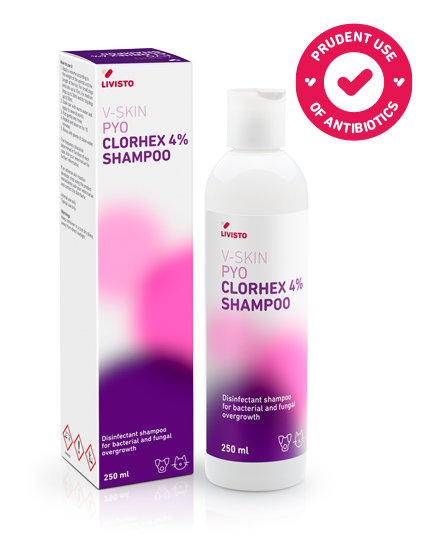SKIN INFECTIONS IN DOGS AND CATS
SKIN INFECTIONS IN DOGS AND CATS
V-SKIN
PYO
CLORHEX 4% SHAMPOO
An effective topical treatment is the key to combatting bacterial and fungal skin infections in cats and dogs.
Clorhex 4% shampoo has antiseptic, antibacterial and antifungal properties to cleanse the skin and wounds, dermatitis and pyoderma.
It is sulphates-free and contains hypoallergenic perfume to reduce skin dryness and treat your pet´s skin with care. With very gentle natural soap derived from coconut oil, keeps the fur clean and soft.

Key points:
- With Chlorhexidine an efficient antibacterial, disinfectant and antiseptic component.1, 2, 3, 4
- Tris-EDTA: antibiofilm component that potentiates the effect of chlorhexidine.5, 6, 7
- Aloe Vera and calendula to soothe and calm the injured skin.8, 9, 10, 11, 12, 13, 14, 15, 16, 17, 18
How to use it:
- Apply an amount appropriate to the weight of the animal and the length of the hair.
- Soak hair with warm water and apply to several points.
- Rub gently and rinse.
- Repeat and leave on for 10 minutes.
- Rinse with plenty of clean water.
- The frequency should be determined according to each individual case.
- Consult your veterinarian.
- Avoid contact with eyes.
Watch the product application video!
Vets opinions
Pleasant smell, leaves a fluffy hair and skin erythema is relieved after use.

References
- Mueller, R. S., Bergvall, K., Bensignor, E., & Bond, R. (2012). A review of topical therapy for skin infections with bacteria and yeast. Veterinary Dermatology, 23(4).
https://doi.org/10.1111/j.1365-3164.2012.01057.x - Denny, J., & Munro, C. L. (2017). Chlorhexidine Bathing Effects on Health-Care-Associated Infections. Biological Research for Nursing, 19(2).
https://doi.org/10.1177/1099800416654013 - Esumi, M., Kanda, S., Shimoura, H., Hsiao, Y. H., & Iyori, K. (2021). Preliminary evaluation of two bathing methods for the management of Malassezia overgrowth in dogs with atopic dermatitis. Veterinary Dermatology, 32(3).
https://doi.org/10.1111/vde.12948 - Wan, J. (2014). A case of methicillin-resistant Staphylococcus pseudintermedius (MRSP) pyoderma in a Labrador retriever dog. Canadian Veterinary Journal, 55(11).
- Swanson, E. A., Freeman, L. J., Seleem, M. N., & Snyder, P. W. (2014). Biofilm-infected wounds in a dog. Journal of the American Veterinary Medical Association, 244(6).
https://doi.org/10.2460/javma.244.6.699 - Wooley, R. E., & Jones, M. S. (1983). Action of EDTA-Tris and antimicrobial agent combinations on selected pathogenic bacteria. Veterinary Microbiology, 8(3).
https://doi.org/10.1016/0378-1135(83)90079-2 - Buckley, L. M., Mcewan, N. A., & Nuttall, T. (2013). Tris-EDTA significantly enhances antibiotic efficacy against multidrug-resistant Pseudomonas aeruginosa in vitro. Veterinary Dermatology, 24(5).
https://doi.org/10.1111/vde.12071 - Hekmatpou, D., Mehrabi, F., Rahzani, K., & Aminiyan, A. (2019). The effect of aloe vera clinical trials on prevention and healing of skin wound: A systematic review. In Iranian Journal of Medical Sciences (Vol. 44, Issue 1).
- Sánchez, M., González-Burgos, E., Iglesias, I., & Gómez-Serranillos, M. P. (2020). Pharmacological update properties of aloe vera and its major active constituents. In Molecules (Vol. 25, Issue 6).
https://doi.org/10.3390/molecules25061324 - Teplicki, E., Ma, Q., Castillo, D. E., Zarei, M., Hustad, A. P., Chen, J., & Li, J. (2018). The effects of aloe vera on wound healing in cell proliferation, migration, and viability. Wounds, 30(9).
- Kamr, A., Arbaga, A., El-Bahrawy, A., Elsify, A., Khaled, H., & Hassan, H. (2020). The therapeutic efficacy of Aloe vera gel ointment on staphylococcal pyoderma in dogs. Veterinary World, 13(11).
https://doi.org/10.14202/VETWORLD.2020.2371-2380 - Arbaga, A., El-Bahrawy, A., Elsify, A., Khaled, H., Hassan, H. Y., & Kamr, A. (2021). Biochemical and histopathological changes related to the topical application of Aloe vera ointment for canine pyoderma. Veterinary World, 14(5).
https://doi.org/10.14202/vetworld.2021.1354-1362 - Preethia, K. C., Kuttanb, G; Kuttan, R. (2009). Anti-inflammatory activity of flower extract of Calendula officinalis Linn. and its possible mechanism of action. Indian Journal of Experimental Biology 2009 47(2).
- Tresch, M., Mevissen, M., Ayrle, H., Melzig, M., Roosje, P.; Walkenhorst, M. (2019). Medicinal plants as therapeutic options for topical treatment in canine dermatology? A systematic review. BMC Veterinary Researc, (1).
https://doi.org/10.1186/s12917-019-1854-4 - Giostri, G. S., Novak, E. M.; Guarita-Souza, L. C. (2021). Treatment of acute wounds in hand with Calendula officinalis L.: A randomized trial. Tissue Barriers.
https://doi.org/10.1080/21688370.2021.1994822 - Cruceriu, D., Balacescu, O; Rakosy, E. (2018). Calendula officinalis: Potential Roles in Cancer Treatment and Palliative Care. In Integrative Cancer Therapies (Vol. 17, Issue 4, pp. 1068–1078). SAGE Publications Inc.
https://doi.org/10.1177/1534735418803766 - Lima, M. dos R., Lopes, A. P., Martins, C., Brito, G. A. C., Carneiro, V. C; Goes, P. (2017). The effect of Calendula officinalis on oxidative stress and bone loss in experimental periodontitis. Frontiers in Physiology, (JUN).
https://doi.org/10.3389/fphys.2017.00440 - John, R.; Jan, N. (2017). Calendula Officinalis-An Important Medicinal Plant with Potential Biological Properties.Proceedings of the Indian National Science Academy,(0).
https://doi.org/10.16943/ptinsa/2017/49126


 We use cookies on our website to give you the most relevant experience by remembering your preferences and repeat visits. By clicking “Accept”, you consent to the use of ALL the cookies. However you may visit Cookie Settings to provide a controlled consent.
We use cookies on our website to give you the most relevant experience by remembering your preferences and repeat visits. By clicking “Accept”, you consent to the use of ALL the cookies. However you may visit Cookie Settings to provide a controlled consent.